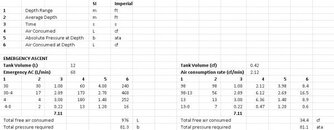I'm an extremely novice diver, 11 dives in fact, and I've gained a lot from this thread. I clearly see the benefit of Rock Bottom/minimum gas planning over the "back on the boat with 50b" theory....
The back on the boat with 50b thing is like asking you to drive around town for a few hours then show up at my house with exactly an 1/16th of a tank of gas in your car...all the while making sure your buddy's vehicle (possibly a gas guzzling s.u.v) makes it as well by donating your fuel to him should he need it. The way I see it you're gonna do one of two things, show up with either too much gas or not enough. Thus cutting your sight seeing short or ending it either dangerously low or running out. I'd rather know exactly what fuel level I needed to head for home safely (R.B.) than to know how much fuel to show up with. (50b 500psi)
Rock bottom or minimum gas gives you the tools to get you back with enough gas, for you and your buddy, without having to GUESS. I've watched the entirety of this thread and even with the stubbornness of some and frustrations of others, one thing has been clear the whole time, DOING THE MATH IS BETTER THAN GUESSING. I thank all of you who participated in this and helped teach me something along the way.
to me, this post makes this thread worthwhile.





